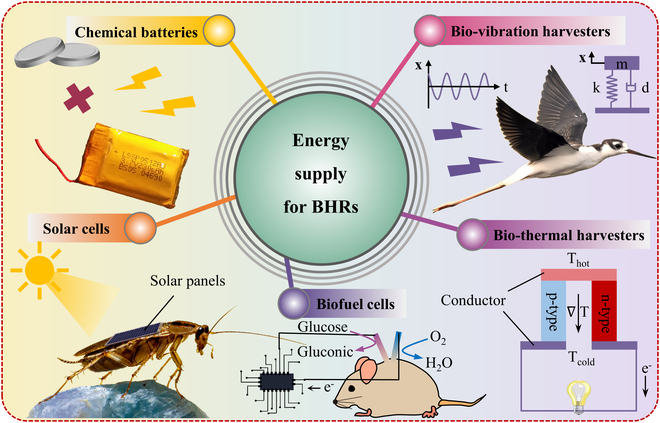| Oct 22, 2023 | |
A review of energy supplies for biomachine hybrid robots |
|
| (Nanowerk News) A recent review from the Beijing Institute of Technology categorizes energy supply methods into five types: chemical batteries, solar cells, biofuel cells, bio-thermal harvesters, and bio-vibration harvesters. | |
Key Takeaways |
|
|
|
|
 |
|
| Scientists from the Beijing Institute of Technology reviewed the various energy supply methods for Biomachine Hybrid Robots. (Image: Jieliang Zhao, Beijing Institute of Technology) | |
The Review |
|
| Bio-machine hybrid robots (BHRs) represent a new generation of micro-aerial vehicles that can be controlled by creating an interface between biological and artificial systems. Unlike conventional bionic robots, they lack complex mechanical structures and have superior mobility and lower energy requirements, thanks to the direct incorporation of animal bodies. As a result, BHRs have a wide range of potential applications including urban and wilderness rescue missions, environmental monitoring, and hazardous area surveys. | |
| To ensure long mission endurance, the energy supply of the control backpack must be carefully considered. Since different biological carriers have varying energy requirements, power supply becomes a critical issue for BHRs. The review paper provides a comprehensive summary of advancements in energy supply devices in BHR research. | |
| Published in the journal Cyborg and Bionic Systems ("A Review of Energy Supply for Biomachine Hybrid Robots"), the review paper offers an exhaustive overview of various energy supply methods used in BHR research. It covers everything from the selection of chemical batteries for different biological carriers to the development and application of various energy harvesters. | |
| "Imagine a future where an animal is the first to notice your distress message and rescue you when you're stranded in the wilderness," explained study author Jieliang Zhao, a professor at the Beijing Institute of Technology. | |
| For years, bionic scientists have sought to replicate the remarkable biological designs and constructions found in nature. While many robots have been designed to mimic animal movement, none have yet matched the efficiency and maneuverability of the animal body itself. | |
| BHRs offer a novel approach. They use animals as carriers and regulate their movements by creating bio-mechanical interfaces to complete specific tasks. According to Zhao, the energy supply unit that powers the control backpack and electronic components carried by the BHRs is crucial for their future development and practical application. | |
| The new review categorizes energy supply devices into five types: chemical batteries, solar cells, biofuel cells, bio-thermal harvesters, and bio-vibration harvesters. It also discusses the unique considerations needed for different carrier animals when choosing chemical batteries. For instance, batteries for flying insects must meet specific weight and size requirements to allow for proper flight. | |
| However, the small size of these batteries means they cannot provide sustainable energy for BHRs, and frequent charging could affect the lifespan of the animal carriers. To address this, researchers have begun developing alternative energy sources like solar cells, biofuel cells, bio-thermal harvesters, and bio-vibration energy harvesters. "Energy harvesters can effectively capture various forms of energy from either the environment or the animal itself, enabling BHRs to be self-powered," said Zhao. | |
| Looking ahead, the team identifies five key challenges that need to be addressed: developing high-energy-density supply devices, ensuring biocompatibility to avoid adverse immune reactions, creating compound energy supplies, maintaining long-term stability, and minimizing environmental impact. | |
| "The research field of energy supply for BHRs is still in its infancy," Zhao noted. Most studies have only been conducted in a laboratory setting, and the output of energy harvesters falls short of actual needs. Despite these challenges, BHRs hold significant potential for future applications such as animal monitoring and wildlife rescue. This review aims to encourage more researchers to focus on solving the challenges related to energy supply and to foster the practical application of BHRs. |
| Source: Beijing Institute of Technology (Note: Content may be edited for style and length) |
We curated a list with the (what we think) 10 best robotics and AI podcasts – check them out!
Also check out our Smartworlder section with articles on smart tech, AI and more.

